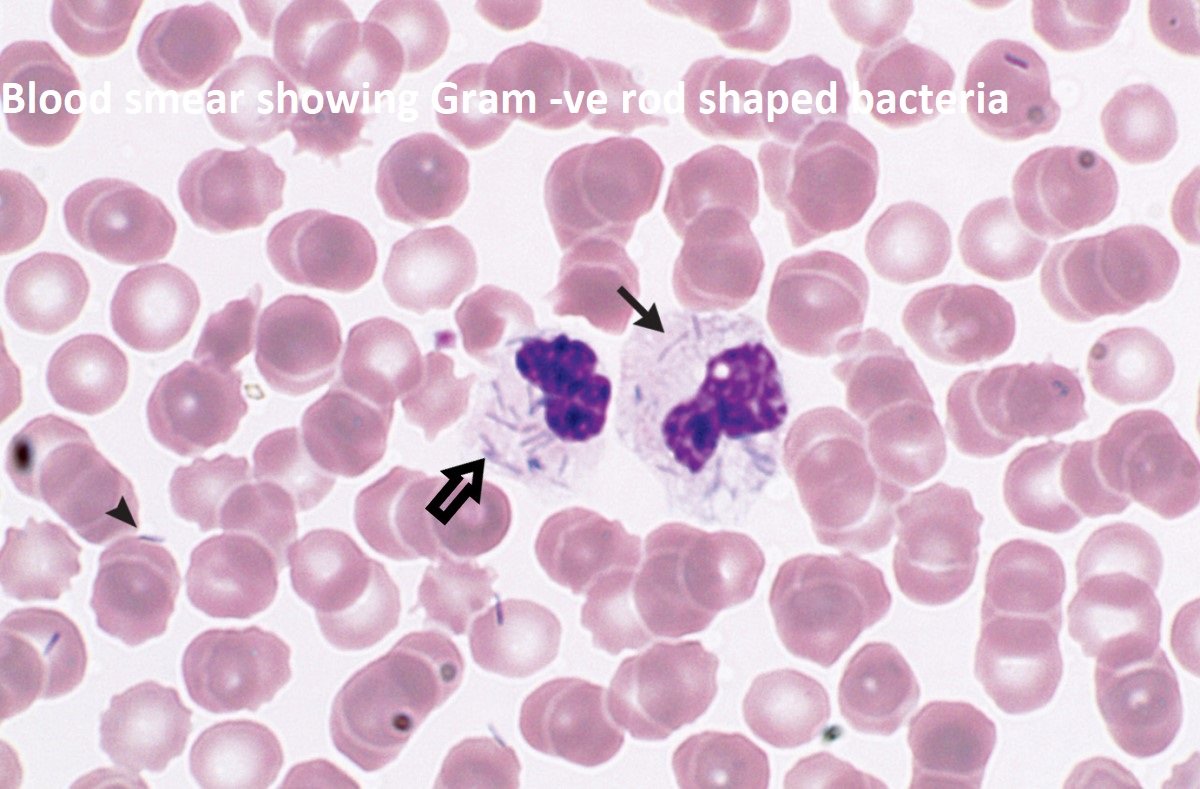A 56 year old man presented to the emergency department with a history of fever and weakness for the past 2 days. The patient mentioned being in good health and not having any active symptoms before 2 days. He denied any sick contacts and denied any family medical history of malignancies. The patient had a dog as pet. He was an active smoker with 30-pack-year smoking history. He is an alcoholic. He had a history of splenectomy 10 years ago after a RTA. On examination, he was tachycardic (112/min) and hypotensive (108/65 mm Hg) at presentation. He had three dog-bite wounds on his left hand. Laboratory studies revealed a WBC count of 16,700/ cubic millimeter with 88% neutrophils. The patient further developed thrombocytopenia (platelet count=18 000 cells/mm3) and acute renal failure with his serum creatinine rising from 1.6 to 6.4 mg/dL during first 48h of hospitalisation. Review of a peripheral-blood smear was as shown. What is the etiology of his illness?

- Pasteurella multocida
- Pasteurella canis
- Capnocytophaga canimorsus
- Bacillus anthracis
Answer
Right Answer is Option 3
Explanation
The patient was atfirst thought to be in sepsis after his presentation to the hospital. He was started on broad spectrum antimicrobial coverage with vancomycin and piperacillin/tazobactam in the first few hours after his presentation. Blood cultures were drawn appropriately prior to starting antimicrobial therapy and were initially positive for Gram-negative rods, but no organism was identified.
The patient progressed to a multiorgan system failure and required prolonged intubation, haemodialysis for his acute renal failure and continuation of his vasopressor support. But after getting Laboratory report of peripheral blood smear shown in the picture suggests Gram -ve rod shaped bacteria and also there are increase in neutrophil counts.
So why Capnocytophaga canimorsus? Because
- Capnocytophaga canimorsus is a slow-growing, Gram-negative rod. It is a commensal bacterium in the normal gingival flora of canine and feline species, but can cause illness in humans. Transmission may occur through bites, licks, or even close proximity with animals. And O/E he had a dog bite on his left arm.
- Certain pre-existing conditions place individuals in a critically high-risk category. Among these are those who have undergone a splenectomy, alcoholics, and individuals with immunosuppression due to the use of steroids such as glucocorticoids. Here in the case the patient was asplenic and also a chronic alcoholic. Of the cases presented in literature, 33% occurred in asplenic individuals, who have decreased IgM and IgG production
After this diagnosis Vancomycin was discontinued at this time and piperacillin/tazobactam was continued for a total of 14 days. The patient had a slow improvement in his clinical symptoms where he was slowly weaned off vasopressor therapy and extubated. His renal functions improved and his serum creatinine stabilised without haemodialysis, and the patient had a resultant good urine output.
C canimorsus is a fastidious Gram-negative bacillus, and part of normal oral flora of dogs and cats. The organism is transmitted to humans by exposure to an animal, usually via bite or scratch and can lead to fulminant sepsis. Capnocytophaga infection can range from self-limited disease to severe infection characterised by DIC and death. Some of the major clinical features described in previous case reports have included cellulitis, meningitis, Sweet’s syndrome, fulminant bacteraemia with septic shock, renal failure, haemorrhagic skin lesions, complicated pneumonias and bacterial endocarditis. Mortality from sepsis secondary to C canimorsus can range from 25% to 60% in patients, with higher mortality among patients presenting in septic shock.





